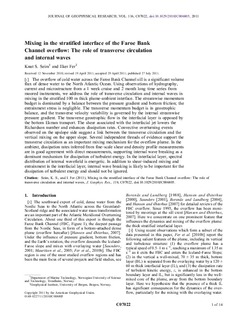| dc.contributor.author | Seim, Knut Sponheim | |
| dc.contributor.author | Fer, Ilker | |
| dc.date.accessioned | 2017-10-17T07:44:57Z | |
| dc.date.available | 2017-10-17T07:44:57Z | |
| dc.date.created | 2011-05-13T15:55:51Z | |
| dc.date.issued | 2011 | |
| dc.identifier.citation | Journal of Geophysical Research. 2011, 116 . | nb_NO |
| dc.identifier.issn | 0148-0227 | |
| dc.identifier.uri | http://hdl.handle.net/11250/2460483 | |
| dc.description.abstract | The overflow of cold water across the Faroe Bank Channel sill is a significant volume flux of dense water to the North Atlantic Ocean. Using observations of hydrography, current and microstructure from a 1 week cruise and 2 month long time series from moored instruments, we address the role of transverse circulation and internal waves in mixing in the stratified 100 m thick plume‐ambient interface. The streamwise momentum budget is dominated by a balance between the pressure gradient and bottom friction; the entrainment stress is negligible. The transverse momentum budget is in geostrophic balance, and the transverse velocity variability is governed by the internal streamwise pressure gradient. The transverse geostrophic flow in the interfacial layer is opposed by the bottom Ekman transport. The shear associated with the interfacial jet lowers the Richardson number and enhances dissipation rates. Convective overturning events observed on the upslope side suggest a link between the transverse circulation and the vertical mixing on the upper slope. Several independent threads of evidence support the transverse circulation as an important mixing mechanism for the overflow plume. In the ambient, dissipation rates inferred from fine‐scale shear and density profile measurements are in good agreement with direct measurements, supporting internal wave breaking as a dominant mechanism for dissipation of turbulent energy. In the interfacial layer, spectral distribution of internal wavefield is energetic. In addition to shear‐induced mixing and entrainment in the interfacial layer, internal wave breaking is likely to be important for the dissipation of turbulent energy and should not be ignored. | nb_NO |
| dc.language.iso | eng | nb_NO |
| dc.publisher | American Geophysical Union (AGU) | nb_NO |
| dc.title | Mixing in the stratified interface of the Faroe Bank Channel overflow: the role of transverse circulation and internal waves | nb_NO |
| dc.type | Journal article | nb_NO |
| dc.type | Peer reviewed | nb_NO |
| dc.description.version | publishedVersion | nb_NO |
| dc.subject.nsi | VDP::Oseanografi: 452 | nb_NO |
| dc.subject.nsi | VDP::Oceanography: 452 | nb_NO |
| dc.source.pagenumber | 14 | nb_NO |
| dc.source.volume | 116 | nb_NO |
| dc.source.journal | Journal of Geophysical Research | nb_NO |
| dc.identifier.doi | 10.1029/2010JC006805 | |
| dc.identifier.cristin | 804890 | |
| dc.relation.project | Norges forskningsråd: 204867 | nb_NO |
| dc.description.localcode | Copyright 2011 by the American Geophysical Union. | nb_NO |
| cristin.unitcode | 194,64,20,0 | |
| cristin.unitname | Institutt for marin teknikk | |
| cristin.ispublished | true | |
| cristin.fulltext | original | |
| cristin.qualitycode | 1 | |
